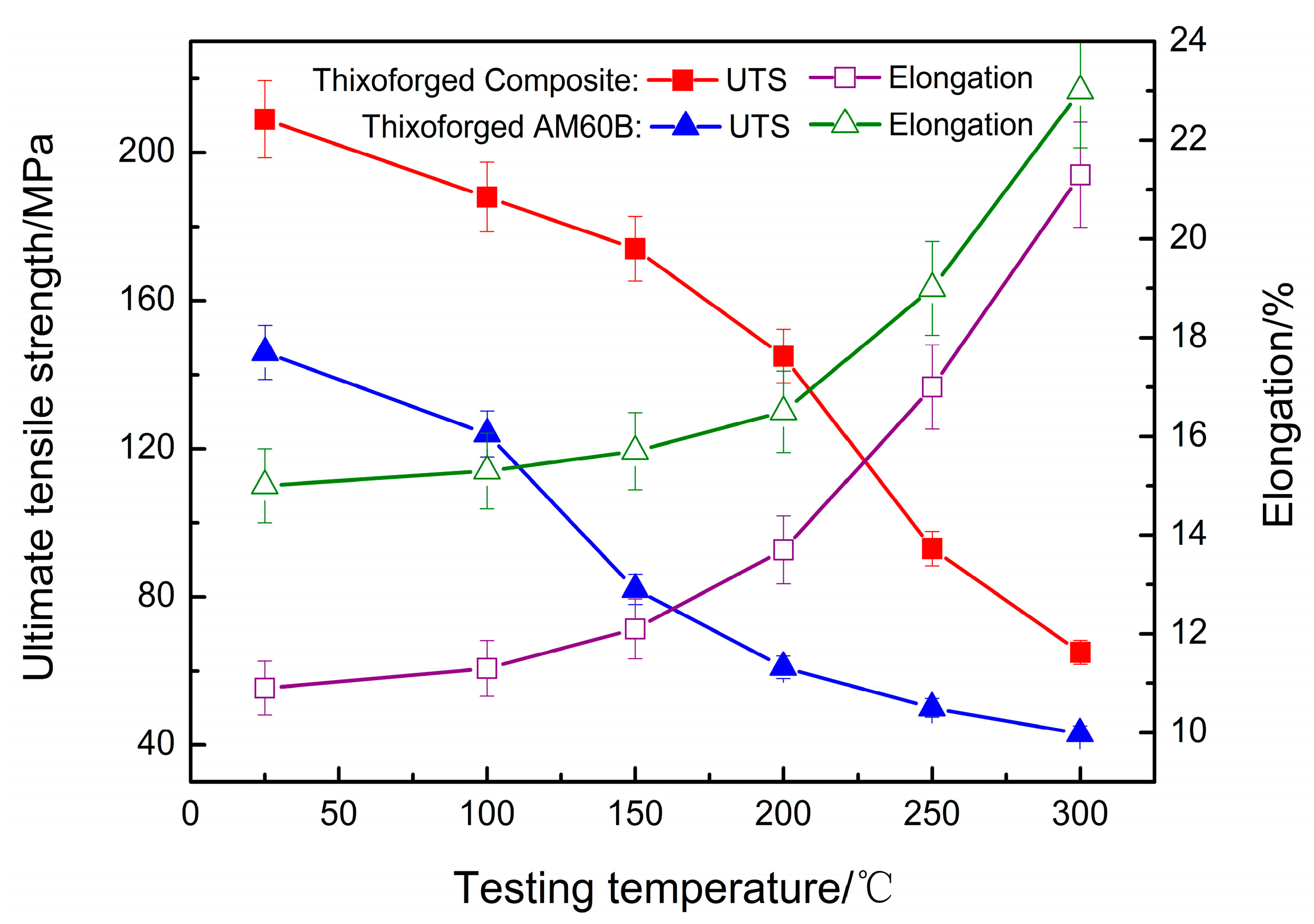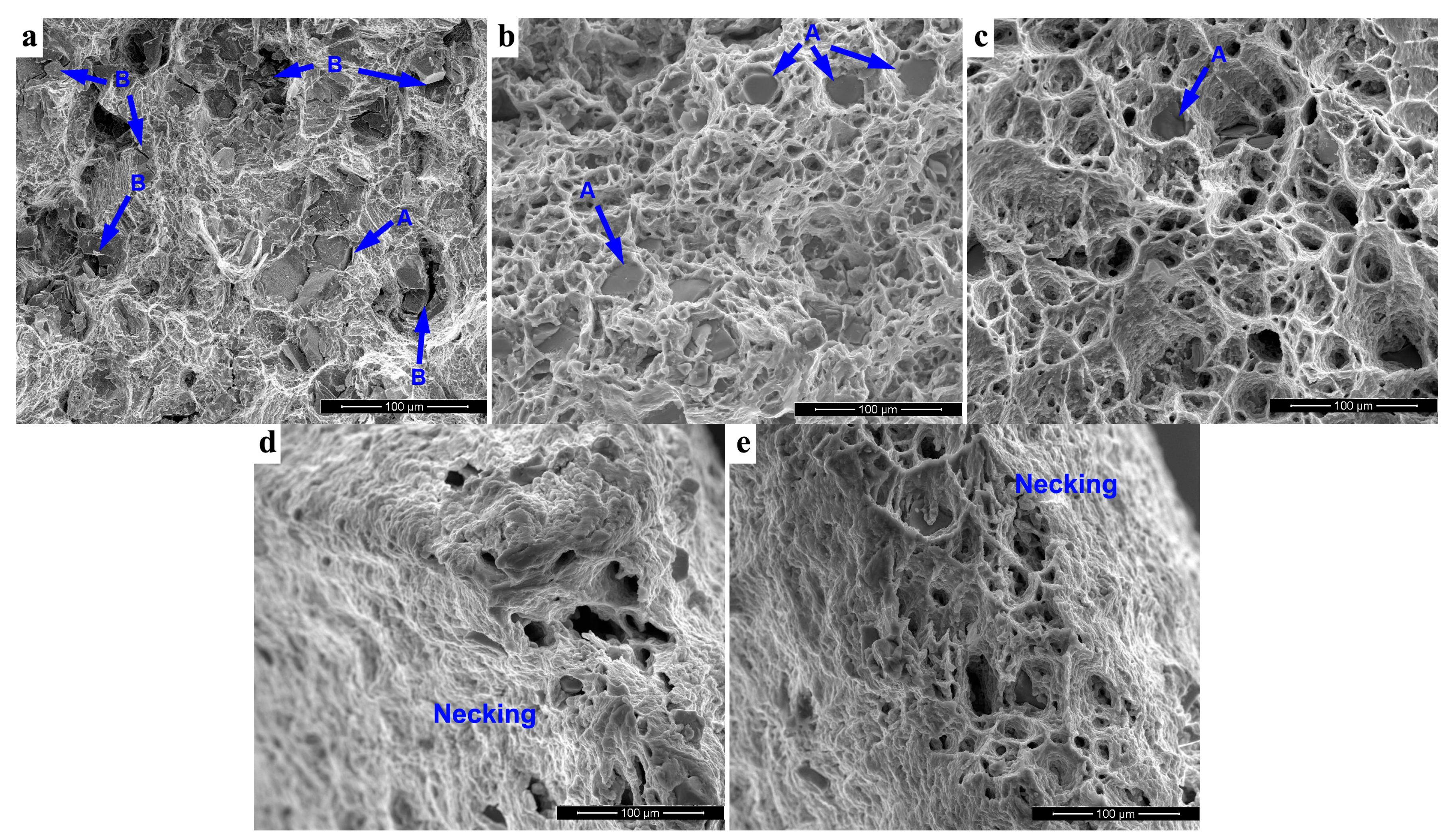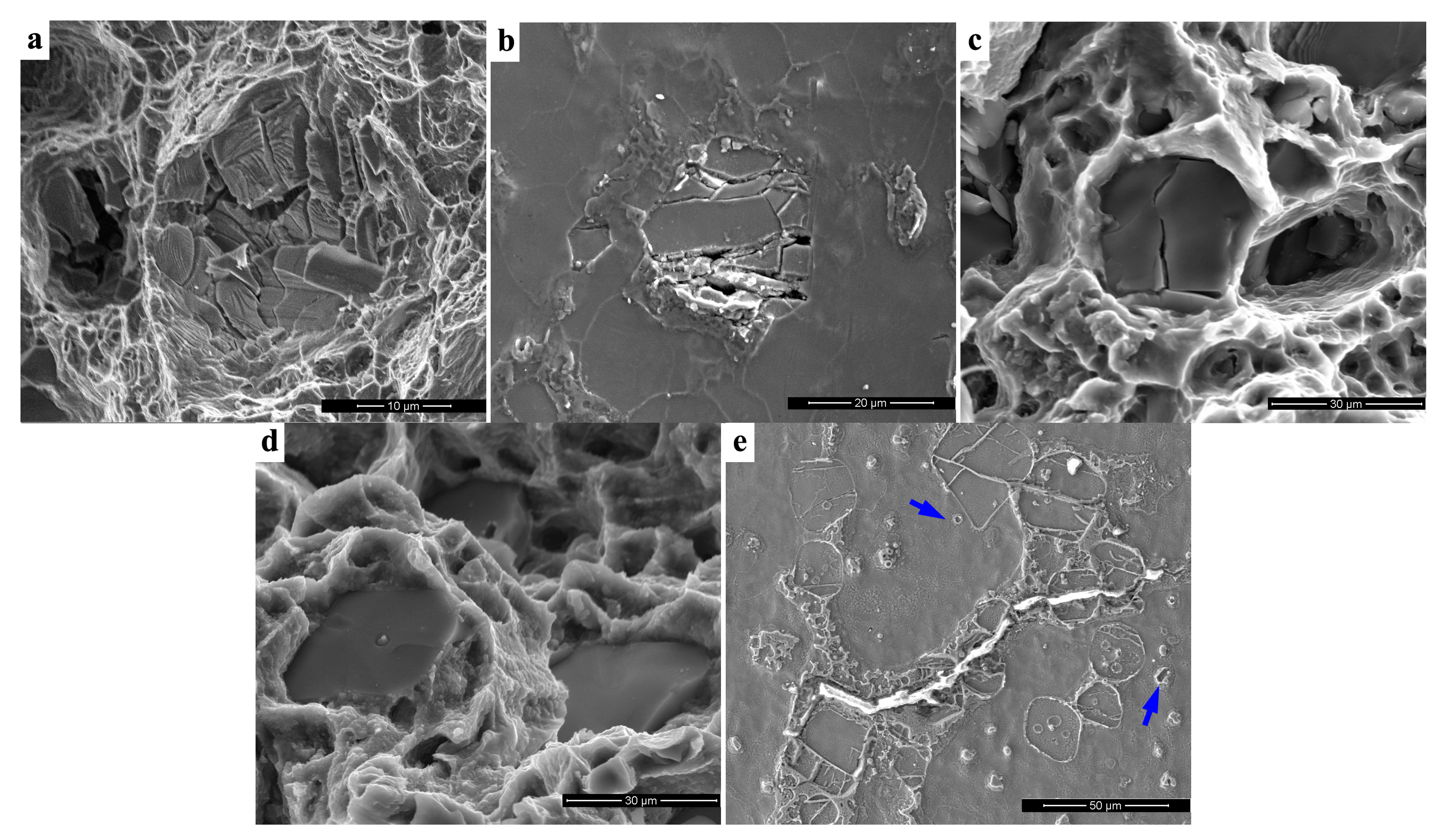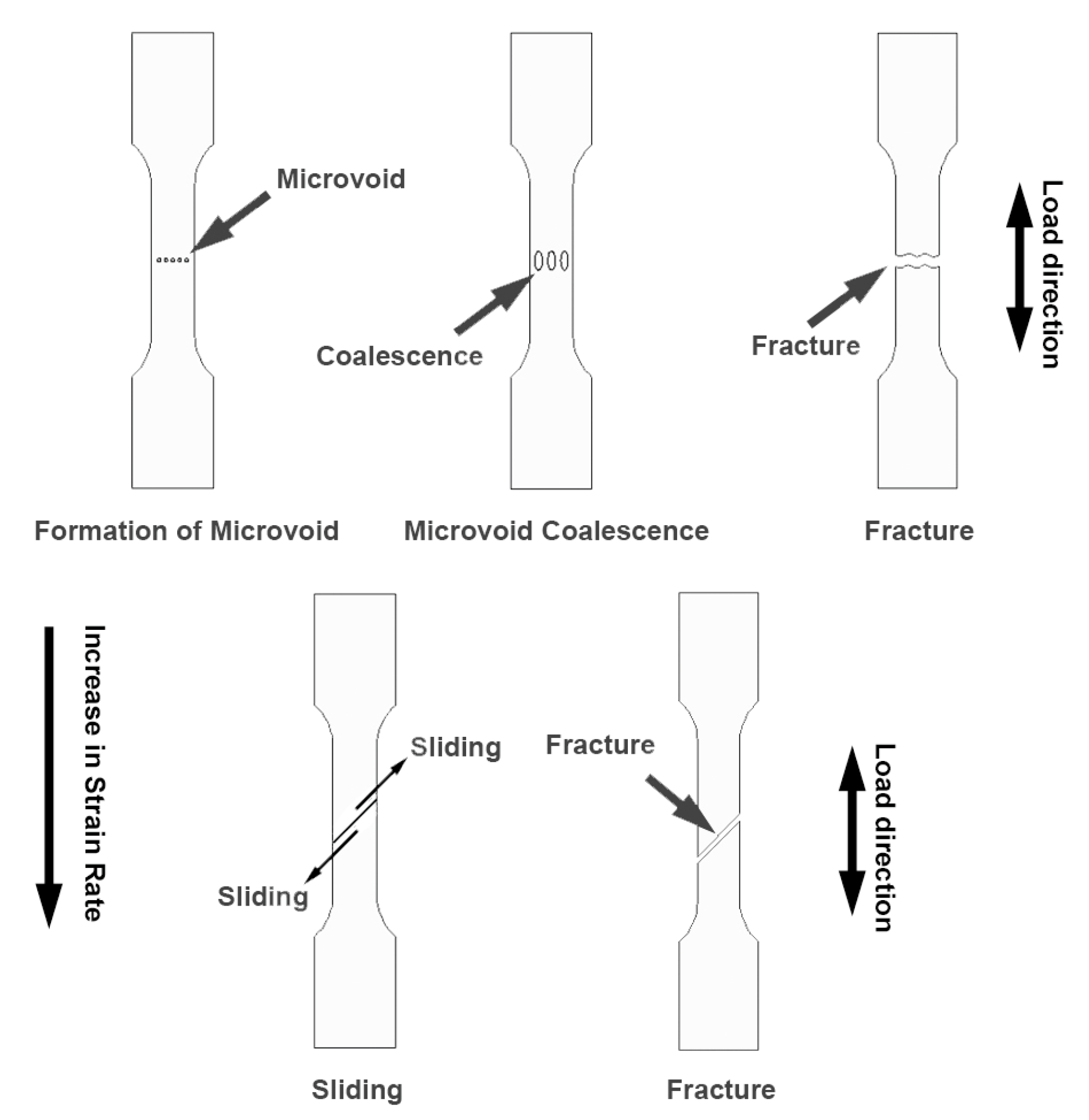Mechanical Properties of Thixoforged In Situ Mg2Sip/AM60B Composite at Elevated Temperatures
Abstract
:1. Introduction
2. Materials and Methods
3. Results
3.1. Microstructures of As-Cast, Semisolid, and Thixoforged Composite and Thixoforged AM60B Alloy
3.2. Tensile Properties of the Thixoforged Composite at Different Testing Temperatures
3.3. Strengthening Mechanisms of the Mg2Si Particle
3.4. Effect of Initial Strain Rate on Tensile Properties
4. Conclusions
Acknowledgments
Author Contributions
Conflicts of Interest
References
- Aghion, E.; Bronfin, B.; Eliezer, D. The role of the magnesium industry in protecting the environment. J. Mater. Process. Technol. 2001, 117, 381–385. [Google Scholar] [CrossRef]
- Luo, A.; Pekguleryuz, M.O. Cast magnesium alloys for elevated temperature applications. J. Mater. Sci. 1994, 29, 5259–5271. [Google Scholar] [CrossRef]
- Zhu, S.; Easton, M.; Abbott, T.; Nie, J.; Dargusch, M.; Hort, N.; Gibson, M. Evaluation of magnesium die-casting alloys for elevated temperature applications: Microstructure, tensile properties, and creep resistance. Metall. Mater. Trans. A 2015, 46, 3543–3554. [Google Scholar] [CrossRef]
- Aghion, E.; Bronfin, B.; Eliezer, D. The art of developing new magnesium alloys for high temperature applications. Mater. Sci. Forum 2003, 419, 407–417. [Google Scholar] [CrossRef]
- Weiss, D.; Kaya, A.A.; Aghion, E.; Eliezer, D. Microstructure and creep properties of a cast Mg–1.7% wt rare earth–0.3% wt Mn alloy. J. Mater. Sci. 2002, 37, 5371–5379. [Google Scholar] [CrossRef]
- Zhang, J.; Leng, Z.; Zhang, M.; Meng, J.; Wu, R. Effect of Ce on microstructure, mechanical properties and corrosion behavior of high-pressure die-cast Mg–4Al-based alloy. J. Alloys Compd. 2011, 509, 1069–1078. [Google Scholar] [CrossRef]
- Hu, H. Squeeze casting of magnesium alloys and their composites. J. Mater. Sci. 1998, 33, 1579–1589. [Google Scholar] [CrossRef]
- Nguyen, Q.B.; Gupta, M. Increasing significantly the failure strain and work of fracture of solidification processed AZ31B using Nano-Al2O3 particulates. J. Alloys Compd. 2008, 459, 244–250. [Google Scholar] [CrossRef]
- Chen, L.; Yao, Y. Processing, microstructures, and mechanical properties of magnesium matrix composites: A review. Acta Metall. Sin. (Engl. Lett.) 2014, 27, 762–774. [Google Scholar] [CrossRef]
- Ye, H.Z.; Liu, X.Y. Review of recent studies in magnesium matrix composites. J. Mater. Sci. 2004, 39, 6153–6171. [Google Scholar] [CrossRef]
- Shen, M.; Ying, T.; Chen, F.; Hou, J. Effect of micro- and nano-SiC particulate reinforcements in magnesium-based metal matrix composites. J. Mater. Eng. Perform. 2016, 25, 2222–2229. [Google Scholar] [CrossRef]
- Guo, W.; Wang, D.; Fu, Y.; Zhang, L.; Wang, Q. Dry sliding wear properties of AZ31-Mg2Si magnesium matrix composites. J. Mater. Eng. Perform. 2016, 25, 4109–4114. [Google Scholar] [CrossRef]
- Lloyd, D.J. Particle reinforced aluminium and magnesium matrix composites. Int. Mater. Rev. 1994, 39, 1–23. [Google Scholar] [CrossRef]
- Nie, K.B.; Wang, X.J.; Wu, K.; Xu, L.; Zheng, M.Y.; Hu, X.S. Fabrication of SiC particles-reinforced magnesium matrix composite by ultrasonic vibration. J. Mater. Sci. 2012, 47, 138–144. [Google Scholar] [CrossRef]
- Zhou, S.; Deng, K.; Li, J.; Shang, S.; Liang, W.; Fan, J. Effects of volume ratio on the microstructure and mechanical properties of particle reinforced magnesium matrix composite. Mater. Des. 2014, 63, 672–677. [Google Scholar] [CrossRef]
- Das, A.; Harimkar, S.P. Effect of graphene nanoplate and silicon carbide nanoparticle reinforcement on mechanical and tribological properties of spark plasma sintered magnesium matrix composites. J. Mater. Sci. Technol. 2014, 30, 1059–1070. [Google Scholar] [CrossRef]
- Xia, K.; Tausig, G. Liquidus casting of a wrought aluminum alloy 2618 for thixoforming. Mater. Sci. Eng. A 1998, 246, 1–10. [Google Scholar] [CrossRef]
- Zhao, Z.D.; Chen, Q.A.; Tang, Z.J.; Hu, C.K. Microstructural evolution and tensile mechanical properties of AM60B magnesium alloy prepared by the SIMA route. J. Alloys Compd. 2010, 497, 402–411. [Google Scholar] [CrossRef]
- Liu, D.; Atkinson, H.V.; Kapranos, P.; Jirattiticharoean, W.; Jones, H. Microstructural evolution and tensile mechanical properties of thixoformed high performance aluminium alloys. Mater. Sci. Eng. A 2003, 361, 213–224. [Google Scholar] [CrossRef]
- Zhang, S.; Chen, T.; Cheng, F.; Li, P. A comparative characterization of the microstructures and tensile properties of as-cast and thixoforged in situ AM60B-10 vol % Mg2Sip composite and thixoforged AM60B. Metals 2015, 5, 457–470. [Google Scholar] [CrossRef]
- Zhang, S.; Chen, T.; Cheng, F.; Li, L. Effects of mould temperature on microstructure and tensile properties of thixoforged Mg2Sip/AM60B in-situ composites. J. Alloys Compd. 2015, 657, 582–592. [Google Scholar] [CrossRef]
- Zhang, S.; Chen, T.; Li, P. Microstructure and tensile properties of in situ Mg2Sip/AM60B composite prepared by thixoforging technology. J. Mater. Res. 2016, 31, 783–796. [Google Scholar] [CrossRef]
- Zhang, S.; Chen, T.; Cheng, F.; Li, L. Microstructural evolution and phase transformation during partial remelting of in-situ Mg2Sip/AM60B composite. Trans. Nonferr. Met. Soc. China 2016, 26, 1564–1573. [Google Scholar] [CrossRef]
- Mabuchi, M.; Kubota, K.; Higashi, K. Elevated temperature mechanical properties of magnesium alloys containing Mg2Si. Mater. Sci. Technol. 1996, 12, 35–39. [Google Scholar] [CrossRef]
- Li, G.H.; Gill, H.S.; Varin, R.A. Magnesium silicide intermetallic alloys. Metall. Mater. Trans. A 1993, 24, 2383–2391. [Google Scholar] [CrossRef]
- Snyder, V.A.; Alkemper, J.; Voorhees, P.W. The development of spatial correlations during Ostwald ripening: A test of theory. Acta Mater. 2000, 48, 2689–2701. [Google Scholar] [CrossRef]
- Yu, B.; Chen, D.; Tang, Q.; Wang, C.; Shi, D. Structural, electronic, elastic and thermal properties of Mg2Si. J. Phys. Chem. Solids 2010, 71, 758–763. [Google Scholar] [CrossRef]
- Arsenault, R.J. Interfaces in metal matrix composites. Scr. Metall. 1984, 18, 1131–1134. [Google Scholar] [CrossRef]
- Arsenault, R.J. Strengthening mechanisms in particulate mmc. Scr. Metall. 1991, 25, 2617–2621. [Google Scholar] [CrossRef]
- Eliezer, D.; Aghion, E.; Froes, F. The science, technology, and applications of magnesium. JOM 1998, 50, 30–34. [Google Scholar]
- Kang, F.; Li, Z.; Wang, J.; Cheng, P.; Wu, H. The activation of <c + a> non-basal slip in magnesium alloys. J. Mater. Sci. 2012, 47, 7854–7859. [Google Scholar] [CrossRef]
- Yin, D.D.; Wang, Q.D.; Boehlert, C.J.; Ding, W.J. Creep and fracture behavior of as-cast Mg–11Y–5Gd–2Zn–0.5Zr (wt %). J. Mater. Sci. 2012, 47, 6263–6275. [Google Scholar] [CrossRef]
- Biswas, S.; Singh, D.S.; Beausir, B.; Toth, L.S.; Suwas, S. Thermal response on the microstructure and texture of ECAP and cold-rolled pure magnesium. Metall. Mater. Trans. A 2015, 46, 2598–2613. [Google Scholar] [CrossRef]
- Liu, S.; Gao, F.; Zhang, Q.; Li, W. Mechanical properties and microstructures of nano-sized SiC particles reinforced AZ91D nanocomposites fabricated by high intensity ultrasonic assisted casting. Mater. Sci. Forum 2009, 618–619, 449–452. [Google Scholar] [CrossRef]
- Li, Z.; Dong, J.; Zeng, X.Q.; Lu, C.; Ding, W.J. Influence of Mg17Al12 intermetallic compounds on the hot extruded microstructures and mechanical properties of Mg–9Al–1Zn alloy. Mater. Sci. Eng. A 2007, 466, 134–139. [Google Scholar] [CrossRef]
- Arsenault, R.J.; Shi, N. Dislocation generation due to differences between the coefficients of thermal expansion. Mater. Sci. Eng. A 1986, 81, 175–187. [Google Scholar] [CrossRef]
- Zhang, D.; Yang, X.; Sun, H.; Li, Y.; Wang, J.; Zhang, Z.; Ye, Y.; Sakai, T. Dynamic recrystallization behaviors and the resultant mechanical properties of a Mg–Y–Nd–Zr alloy during hot compression after aging. Mater. Sci. Eng. A 2015, 640, 51–60. [Google Scholar] [CrossRef]
- Roodposhti, P.S.; Sarkar, A.; Murty, K.L. Microstructural development of high temperature deformed AZ31 magnesium alloys. Mater. Sci. Eng. A 2015, 626, 195–202. [Google Scholar] [CrossRef]
- Fadavi Boostani, A.; Yazdani, S.; Taherzadeh Mousavian, R.; Tahamtan, S.; Azari Khosroshahi, R.; Wei, D.; Brabazon, D.; Xu, J.Z.; Zhang, X.M.; Jiang, Z.Y. Strengthening mechanisms of graphene sheets in aluminium matrix nanocomposites. Mater. Des. 2015, 88, 983–989. [Google Scholar] [CrossRef]
- Watanabe, H.; Ishikawa, K. Effect of texture on high temperature deformation behavior at high strain rates in a Mg–3Al–1Zn alloy. Mater. Sci. Eng. A 2009, 523, 304–311. [Google Scholar] [CrossRef]
- Ulacia, I.; Dudamell, N.V.; Gálvez, F.; Yi, S.; Pérez-Prado, M.T.; Hurtado, I. Mechanical behavior and microstructural evolution of a Mg AZ31 sheet at dynamic strain rates. Acta Mater. 2010, 58, 2988–2998. [Google Scholar] [CrossRef]









© 2018 by the authors. Licensee MDPI, Basel, Switzerland. This article is an open access article distributed under the terms and conditions of the Creative Commons Attribution (CC BY) license (http://creativecommons.org/licenses/by/4.0/).
Share and Cite
Zhang, S.; Chen, T.; Zhou, J.; Xiu, D.; Li, T.; Cheng, K. Mechanical Properties of Thixoforged In Situ Mg2Sip/AM60B Composite at Elevated Temperatures. Metals 2018, 8, 106. https://doi.org/10.3390/met8020106
Zhang S, Chen T, Zhou J, Xiu D, Li T, Cheng K. Mechanical Properties of Thixoforged In Situ Mg2Sip/AM60B Composite at Elevated Temperatures. Metals. 2018; 8(2):106. https://doi.org/10.3390/met8020106
Chicago/Turabian StyleZhang, Suqing, Tijun Chen, Jixue Zhou, Dapeng Xiu, Tao Li, and Kaiming Cheng. 2018. "Mechanical Properties of Thixoforged In Situ Mg2Sip/AM60B Composite at Elevated Temperatures" Metals 8, no. 2: 106. https://doi.org/10.3390/met8020106




